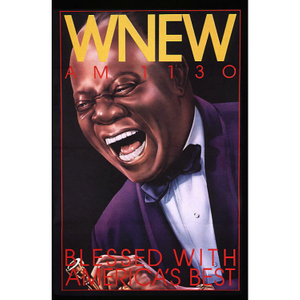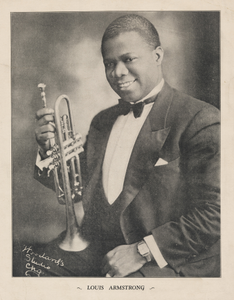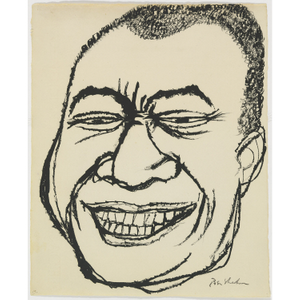Description
A trumpet virtuoso and innovative vocalist, jazz pioneer Louis Armstrong helped to transform jazz into an international phenomenon. Raised in New Orleans, where he first learned to play the cornet, Armstrong was recruited for “King” Oliver’s Chicago-based Creole Jazz Band in 1922. When the opportunity to perform with Fletcher Henderson’s orchestra took Armstrong to New York City in 1924, his technical prowess and rhythmic ingenuity played a critical role in the development of the new musical style known as “swing.” After forming his own band––the Hot Five––in 1925, Armstrong made a series of memorable recordings that secured his reputation as both the first great jazz soloist and a vocalist as skilled at “scat” singing as he was at melody. Armstrong’s career flourished throughout the swing era. When swing gave way to bebop following World War II, Armstrong rode the wave of the Dixieland jazz revival, becoming its most popular performer.Virtuoso de la trompeta y vocalista original, Louis Armstrong fue un pionero del jazz que ayudó a transformar el género en un fenómeno internacional. Armstrong creció en New Orleans, donde aprendió a tocar la corneta, y en 1922 fue reclutado por “King” Oliver para su Creole Jazz Band, radicada en Chicago. En 1924 se le presentó la oportunidad de tocar con la orquesta de Fletcher Henderson en New York, donde su maestría técnica y su genio rítmico fueron factores cruciales en el desarrollo del nuevo estilo conocido como swing. Después de fundar su propia banda, Hot Five, en 1925, Armstrong grabó...
Image
Selenium Toned Gelatin Silver Print
National Portrait Gallery, Smithsonian Institution
Record Contributed By
National Portrait GalleryRecord Harvested From
Smithsonian InstitutionKeywords
- Actor
- Actors And Actresses
- Armstrong, Louis
- Comedian
- Container
- Containers
- Design
- Drinking Vessel
- Entertainers
- Glass
- Home Furnishings
- Horn
- Interior
- Interior Decoration
- Jazz
- Leonard, Herman
- Louis Armstrong
- Male
- Men
- Motion Pictures
- Movie
- Music
- Musical Instrument
- Musical Instruments
- Musician
- Musicians
- Performer
- Performing Arts
- Pitcher
- Portrait
- Portraits
- Singer
- Trumpet
- Trumpets





















